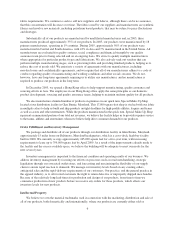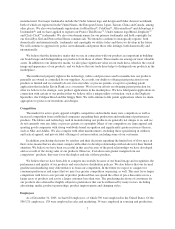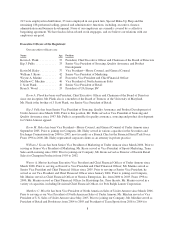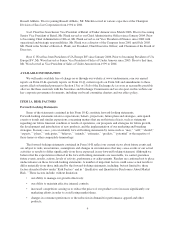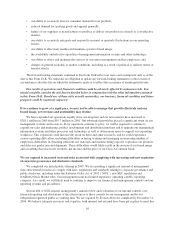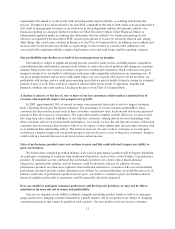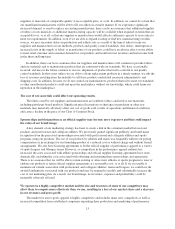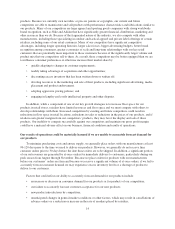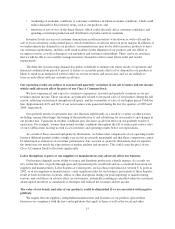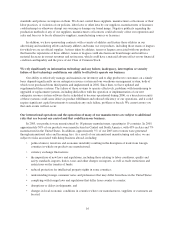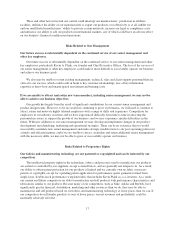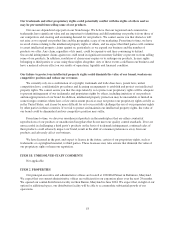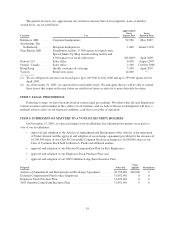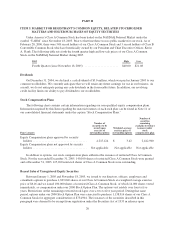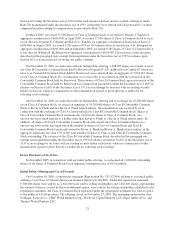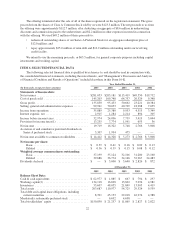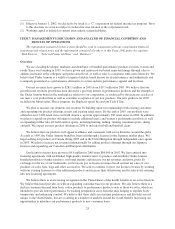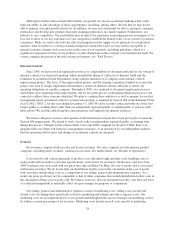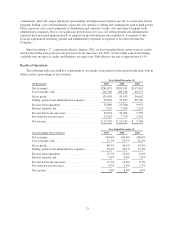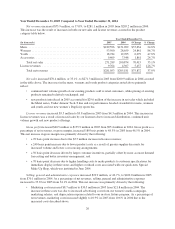Under Armour 2005 Annual Report Download - page 22
Download and view the complete annual report
Please find page 22 of the 2005 Under Armour annual report below. You can navigate through the pages in the report by either clicking on the pages listed below, or by using the keyword search tool below to find specific information within the annual report.standards and policies we impose on them. We do not control these suppliers, manufacturers or licensees or their
labor practices. A violation of our policies, labor laws or other laws by our suppliers, manufacturers or licensees
could interrupt or otherwise disrupt our sourcing or damage our brand image. Negative publicity regarding the
production methods of any of our suppliers, manufacturers or licensees could adversely affect our reputation and
sales and force us to locate alternative suppliers, manufacturing sources or licensees.
In addition, we have sponsorship contracts with a variety of athletes and feature those athletes in our
advertising and marketing efforts and many athletes and teams use our products, including those teams or leagues
for which we are an official supplier. Actions taken by athletes, teams or leagues associated with our products
that harm the reputations of those athletes, teams or leagues could also harm our brand image and result in a
material decrease in our net revenues and net income, which could have a material adverse effect on our financial
condition and liquidity and the price of our Class A Common Stock.
We rely significantly on information technology and any failure, inadequacy, interruption or security
failure of that technology could harm our ability to effectively operate our business.
Our ability to effectively manage and maintain our inventory and to ship products to customers on a timely
basis depends significantly on our enterprise resource system and our warehouse management system, both of
which were purchased from third parties and implemented in 2002. Since then, we have updated and
supplemented these systems. The failure of these systems to operate effectively, problems with transitioning to
upgraded or replacement systems, including difficulties with the operation or implementation of our new
enterprise resource system software that is scheduled to become operational during 2006, or a breach in security
of these systems could cause delays in product fulfillment and reduced efficiency of our operations, and it could
require significant capital investments to remediate any such failure, problem or breach. We cannot assure you
that such events will not occur.
Our international operations and the operations of many of our manufacturers are subject to additional
risks that are beyond our control and that could harm our business.
In 2005, our products were manufactured by 18 primary manufacturers, operating in 19 countries. In 2005,
approximately 50% of our products were manufactured in Central and South America, with 43% in Asia and 7%
manufactured in the United States. In addition, approximately 5% of our 2005 net revenues were generated
through international sales and licensing fees. As a result of our international manufacturing and sales, we are
subject to risks associated with doing business abroad, including:
• political unrest, terrorism and economic instability resulting in the disruption of trade from foreign
countries in which our products are manufactured;
• currency exchange fluctuations;
• the imposition of new laws and regulations, including those relating to labor conditions, quality and
safety standards, imports, duties, taxes and other charges on imports, as well as trade restrictions and
restrictions on the transfer of funds;
• reduced protection for intellectual property rights in some countries;
• understanding foreign consumer tastes and preferences that may differ from those in the United States;
• complying with foreign laws and regulations that differ from country to country;
• disruptions or delays in shipments; and
• changes in local economic conditions in countries where our manufacturers, suppliers or customers are
located.
16


